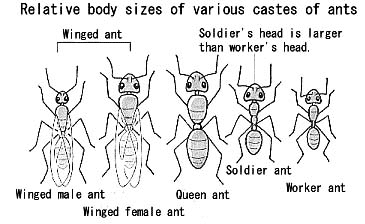
|
Winged ants and wingless ants |
|||||
| Most ants are wingless. However,
from spring to summer, ants that do have wings are seen flying in the air
and swarming around the lights in our homes and other places. Are the species of winged ants different from those of ants moving on the ground? |
|||||
|
While all the ants in these photographs are individuals of the Camponotus japonicus species, male ants have wings (as shown in the photo at the left) and worker ants are wingless (as shown in the circled photo at the right). |
|||||
| Most animal species can be divided
into two forms: males and females. On the other hand, ants can be classified
into three forms, consisting of males, females and workers. Because young
male and female ants have wings, they are called winged ants. Winged female
ants are ordinarily larger than winged male ants. The ants that are generally seen are worker ants. Workers are female ants that cannot lay eggs because their reproductive organs are not well developed. Worker ants with an especially large-sized body and head are sometimes called soldiers. |
 |
||||

A worker ant (left) of the Pheidole nodus species feeding a soldier ant of the same species (right) |
 |
||||